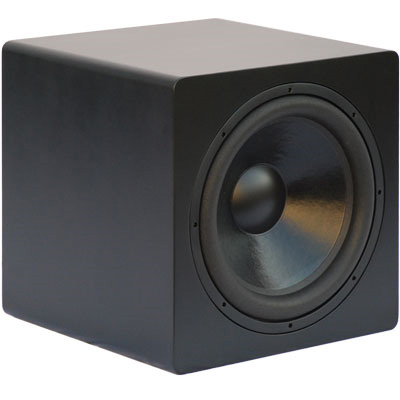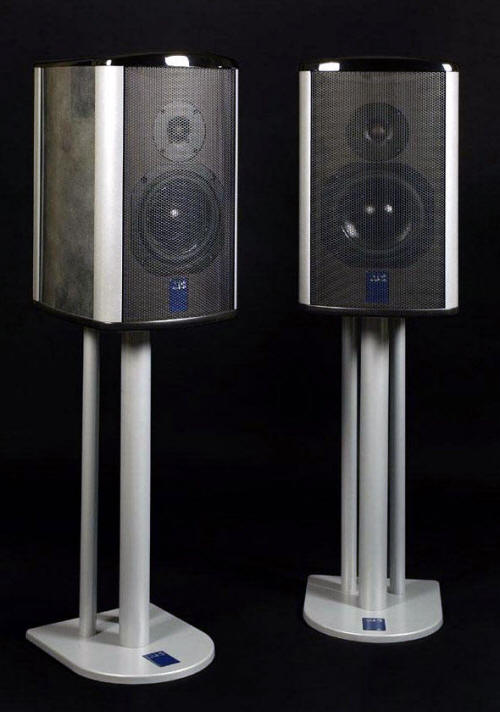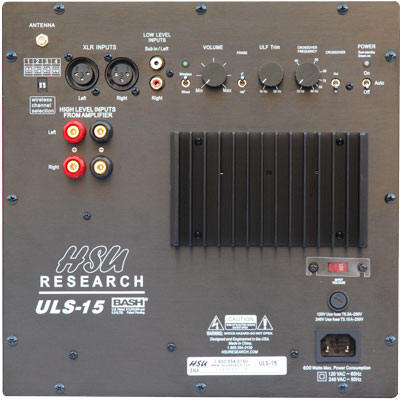
You are reading the older HTML site
Positive Feedback ISSUE
44july/august 2009
hsu research
ULS-15 subwoofer
as reviewed by Larry Cox

|
LARRY COX'S SYSTEM
LOUDSPEAKERS
ELECTRONICS
SOURCE
CABLES
ACCESSORIES
|
When I was listening to the very expensive ATC SCM100asl speakers ($26,500) I was really taken by their excellence. Music was communicated with power, effortlessness, and bandwidth to remove all questions of timbrel or dynamic sufficiency, at least for me. As for the "spectator sport" of soundstaging, that too was excellent. The scale of the performance was easily and immediately communicated on a much larger tapestry than my otherwise fine ATC SCM20-2A speakers.
Although they are sonically of the same ilk as my ATC 20-2asl's ($8300) the larger model's majestic presentation and composure at all frequencies and volumes left me wishing and wanting what they provided. The experience was something akin to Pandora's Box, once the 100asl's opened the window on that experience, the absence of its qualities remains in view.
Returning to my 20-2asls was then, a bit of a let down, even though they are excellent and perform well beyond expectations for their size and cost. My speakers were a clearly less full sounding speaker. As I pined away for a speaker that I realistically should not try to afford while still planning to retire some day, I recalled Billy Woodman of ATC saying something to the effect that the dynamic range is a function of bandwidth. Thus, a limited bandwidth speaker is capable of less dynamic range than a wider bandwidth speaker; whether that's experiential or measurable, I don't recall. In any event, that comment came to mind as I was planning my audio future without the big devils.

I gave myself the task to retrieve as much of the sound of a $25,000+ speaker as I could with my existing system. Naturally or obviously this sent me looking into subwoofers. Well, the common (as in wide spread) sense is that subwoofers are really hard to get to sound good. Go to subwoofer bulletin boards and you'll see terra bytes of arguments for how and why it's hard to get integration with subwoofers and measurements to prove it.
I owned one of Poh Hsu's TN1220 cigar shaped subwoofers along with a Bash amplifier to drive it. I loved it, and my brother-in-law has loved for a while. Hsu products have been widely praised for both their overall quality and what they deliver at relatively low prices.
Secondly, the ULS is a front firing subwoofer. Some subwoofer designers (including ATC) will tell you that it is much easier to achieve excellent sound with a down firing woofer than a front firing one. While that may be true in many domestic installations, it's not so with my house. Front firing subwoofers, including the woofers on my GamuT L5 speakers provided plenty of bass. But, even ATC's massive down-firing C4 sub didn't cut the mustard in my listening room. I think the quality of the down firing arrangement presumes a slab foundation into which the downward firing subwoofer is pointed, which in turn serves to reflect the bass energy.
Alas my house or more specifically, my listening room is directly above the garage of our house. Our house is designed to flex with earthquakes. The garage location and the room's construction swallows downward firing subwoofers, at least in the room, while the garage features prodigious though overblown bass. Naturally then, the ULS-15, a front firing woofer, was attractive for my implementation.
There is a lot of folklore within the topic of subwoofers, and I'm not going to trot out much of it here. Some posit that a sealed main speaker must be mated with a sealed subwoofer and a ported subwoofer should be matched with a ported main speaker. ATC's subwoofers are ported and they match their subs with both ported and sealed speakers within their own line, and so I respect ATC's knowledge of speakers too much to buy that model. Just ask Sony why they debuted SACD using a 5.1 ATC system, including subwoofers. Previously Hsu made only ported subwoofers.
Hsu has actually marketed their subs to be tunable using their ports to allow users to choose deeper bass or greater volume levels. So, whatever the ultimate truth is, it appears that Hsu isn't wedded to one design over the other, which I think says enough about that potential controversy.
What really intrigued me about the ULS-15s, however, was its use of wireless technology. No interconnects are necessary to feed the ULS-15 a signal. Given how hard I heard it was to get the "right" positioning for a subwoofer, I wanted correct placement open to allow property placement free of having the correct length of wiring. So, the ULS-15 seemed attractive.
Some of the humdrum but helpful information about the ULS first. Not surprisingly, the ULS-15 has a fifteen inch subwoofer and weighs in at 90 lbs. It's a hulking figure, though my wife grew accustomed to its size, after a while. It's paired with a rear, flush mounted plate amplifier capable of delivering 1000 short term watts. To quote from Hsu's home page about the quality of their driver, "The motor force is linear within 2% over an ultra wide +/- 20 mm. In contrast, most woofers with Xmax of +/- 30 mm will have the motor force within 2% over 5 mm or less." Pretty impressive results.

Controls on the back are mostly similar to other subwoofers; it can be connected at line level or at speaker level (meaning you connect the subwoofer in series with your main speaker). Two XLR inputs are available. There is a low pass filter (meaning only the signals below a certain level are passed), variable phase control (meaning you can set the subwoofer to change the phase angle to match the main speakers in your room). There is also a ULF, or ultra low frequency trim dial, which is designed to adjust the "q" or damping of the subwoofer. Oh and there is that wireless connection.
In action, the wireless part of the ULS works like this: run an interconnect from the "output" stage of your phono to a wireless transmitter, choose the setting or transmission or broadcast of the bass signal. At the subwoofer, the user chooses the same one of the three settings on the subwoofer to receive the wireless transmission and you are good to go. The subwoofer features a small antenna that receives the signal from the transmitter, it's small and was not visible from my listening seat.
The manual warns that positioning the transmitter can be an issue with signal transmission. I was unable to detect any problems associated with the radio frequency transmission of the signal, i.e. there was no breakup. Moving furniture in my listening room did not affect the signal or its quality. In short, my "open structured" Lovan rack was not an issue. Perhaps an enclosed entertainment center might present an issue.
A small caveat I've read about wireless transmitters is the technology has the potential to interfere with other wireless devices, though I had no issues with either our wi-fi router or our cordless phones. For what it's worth, the selectable settings mentioned above can facilitate avoiding such interference with other devices in your house, but I didn't need to experiment to find out the impact of different settings. Though we have had occasional problems with my neighbor's ham radio transmissions affecting our phones or stereo we still experienced no issues with the Hsu.
The good news here is that the quality of interconnect to transmitter doesn't seem to matter, nor does the power cord make any noticeable difference in the quality of the ULS-15's sound.
Setup
OK, perhaps I'm lucky. Perhaps I'm not discerning. I don't know, but I had very little trouble getting the ULS-15 to sound terrific. I had the good fortune to have Dr. Hsu deliver the ULS-15 to me and set it up. Perhaps that helped. But, truth be told, Dr. Hsu almost plopped it in place, just outside my right speaker, near the "right wall" (a corner) and positioned slightly (about eight inches) behind the main speaker.
I moved the subwoofer around during the three months I had it in search of better sonic positioning, better visual placement, and various other factors. While I was able to find poor positioning, I was able to get the subwoofer back into a high performing condition with little trouble. Additionally, given my hobby and a very accommodating wife, I rarely think of what's visually acceptable to her, I usually just think, where should I place a speaker. If you think differently, you might have issues with placement. But, there's another condition that probably helped me too.
My ATCs are a nearfield speaker. I've commenced listening to the speakers on the short legs of a triangle, i.e. each speaker is closer to me than they are to one another. And, I'm listening three to five feet from the front plane of the speakers. The speakers are about eight feet apart. The best position for the subwoofer was just outside the right speaker and in a room corner, just slightly behind the plane of the speakers.
At my listening position, with this setup, there is very little in the way of room reflections, which probably helped make integration easier, i.e. I may have eliminated the problems of integration by listening nearfield. However, when I placed the ULS-15 to the side of my listening position in a neat, very convenient, little alcove we have, the bass dropped out at the same listening position, and was dramatically attenuated. This position would be an example of poor bass response, probably because of a lot more room interaction and a greater distance to the listening position.
When Dr. Hsu brought the subwoofer he stuck around for about two hours of listening. We worked through a lot of digital and vinyl software of mine, but he brought along some interesting disks himself. What was interesting was that really deep bass, as in down to 10 Hz, the bottom of the ULS-15's range is really rare. Even on movie soundtracks there were only a few seconds of really deep bass. And, I'll say thank God.
I have heard of bass that goes so deep it makes you feel nauseated but had not experienced it. Now I have. Really deep bass massaging your gut is an experience akin to smelling a skunk. You can read the words and have no sense of the experience. If you've never smelled a skunk, you cannot fathom how a smell could function as one of Darwin's deterrents; however, once you've smelled a skunk, it's an experience you're grateful not to experience again, and something about which you will never require further explanation. Ditto with bass in the 10Hz range, although I'd definitely take 10Hz bass over smelling a skunk. If segueing from skunks to the depth of the ULS-15's bass via nausea isn't exactly welcoming, the ULS-15's performance certainly was.
Throughout my listening sessions I tended to have the subwoofer low passing around 40Hz, or at least what the dial on the crossover seemed to suggest would be 40Hz. I chose that setting to allow the Hsu to work in a more optimal range for it and to let my ATCs work in their range, though my preamp does not cut off the low-end reproduction of my powered speakers. The ULS-15 subwoofer was robust as hell.
Dr. Hsu listens at loud levels; really loud. Or at least he does when he's listening to other people's speakers. When I can, I tend to listen at higher volumes for much the same reason that people visit the Grand Canyon, rather than settle on a picture - scale models fail to adequately convey reality; or said differently, original volume levels are necessary to get the proper experience of live music. You don't get the same perspective on a performance played at low levels.
Dr Hsu's levels, however, were so high that my previously unflappable ATCs exhibited strong, easily visible, and dramatic distortion of the bass driver, on the order of perhaps one half to a full inch. Scary. Though I was diggin' the experience I popped up out of my seat to rescue my speakers. The ULS did not seem anywhere near breaking up though my professional monitors had clearly gone over the edge.
The event also demonstrated something important to know about subwoofers and music. Even though the ULS-15 can go to 10Hz, the population of 10Hz animals is quite rare and I think that's why my speakers broke up: there was clearly lots of bass. These recordings were, after all, the most bass abundant tracks I could find. Having said that, my little 6.5 inch woofers were doing the majority of the work, because there is far more bass in the range of my main speakers than the Hsu had to handle in its range.
This is not to say that the ULS-15's ability to go to 10Hz is a waste, because it's no more wasteful than a car that can go 120 miles per hour in a world with a speed limit of 65 mph. It's not wringing the last iota of deeeeeeeep bass (or top speed) that's important, though fun; it's that a sub that can do 10Hz well can also do 20Hz or 30Hz with ease and aplomb as well as a car that can do 120 also accelerates quickly from 65 to 80 to pass another car. Yeah, it's useful.
Dr. Hsu and I worked through recordings like Mobile Fidelity's Edward Elgar Sanguine Fan, a Sheffield Lab Recording, Die Walkure: Ride of the Valkyries, and about two hours of LPs of various stripes with as much deep bass as I could think of. As allowed by the recordings they were beautifully and deeply supported by the ULS-15.
So, why a sub? Well, subs allow for more foundation that has a surprising impact on imaging of instruments and developing "space" for instruments in complex mixes. For some reason adding bass to a system increases the soundstage specificity as well as seeming to sort out, if not add space between images and unravels instruments in complex passages. And, while that may seem unimportant, it really adds to the audio experience.
A single Hsu ULS-15 ($1299 in satin black, other finishes are a bit higher) performed at a much higher level than the eight inch drivers in the pair of Acculine A-Subs ($239/each) I had in for review previously. Bass was noticeably deeper, faster and with substantially more impact.
Integration with a faster subwoofer was much easier with my electrostatic-like ATCs. I set the volume level higher on the ULS-15 to more closely match that of my main speakers. The ULS-15 got me closer to the immersion that the ATC SCM100s provided, though they did nothing to increase the size of images—this, I believe, requires an increased distance between the drivers on the main speakers. Still, the Reference Recordings 20th Anniversary CD, tracks three and four ("Mestizo Waltz" and "Prelude on B-A-C-H") nearly matched my recollection of the weight and dynamics of the way more expensive ATC 100s handled these tracks.
Movies
Rumbling boulders and mountain ranges ("Ice Age"), thunderous hordes ("Lord of the Rings") and space ships ("Lost in Space," "Robots," and "Galaxy Quest"), racing cars ("Cars") and a host of other such films transformed our too occasional "grown up" movie fare. (versus unending hours of hearing Bob the Builder, Thomas the Tank Engine, and Caillou) And, frankly, you'd be surprised at how many dramas use a full sound to gather your attention in anticipation of some horrible thing happening. While we tend to be primarily "drama" watchers, the ULS-15 added a lot to the movie experience, making it a welcome addition.
While I had the ULS-15s in house, my neighbor Stew came for a visit. He's a retired jazz drummer. He wanted a lot more bass than I had dialed in, so we upped the volume level and increased the crossover level so that the subwoofer delivered more bass higher up in frequency. When we reached his "now you're talking bass levels" the sound was overblown, the location of the subwoofer and its impact on the sound was quite obvious. Imaging was no longer exceptional and I was listening to a stereo again, instead of seemingly immersed in a recording.
For me the point of a subwoofer was to increase the foundation without noticing the driver. Stew, on the other hand, seemed to want the subwoofer to act like a kick drum, with its own sound and easily identified location. The "extra bass" was definitely that and it certainly gave a greater sense of bottom end weight and heft, but it also pointed to the exactly bass location and when the Hsu's "solo" entered and exited the mix. Fun for awhile, but not something I would live with.
I wonder, not having had the experience, whether the subwoofers retailing for multiples of the cost of the ULS-15 would provide the bass that Stew wanted with the seamless integration I require? Some people argue that the mega buck subs are "better." I hear a difference between the ATC 20s matched with the ULS-15 and ATC's 100s, and that's good to know; but it was close enough that I'd have no question that saving $20,000 would be my first choice.
During the time I had the ULS-15, I initially rifled through my 1200+ LP and CD collection for music with lots of bass or deep bass. But over time I started thinking about albums that I've had enjoyed over my 35 years of audiophilia wondering what "real bass" might add to those recordings. And that led to scouring my collection for various pieces from The Strawbs, Pink Floyd, Aerosmith, Pablo Cruise, and more that I rarely listen to any more. And that led me to listening to LPs I listened to during the 1970s. And that led me to hoping that Dr. Hsu had forgotten that I had his subwoofer. Regrettably he has a memory. Yeah, I did some rediscovering and that was a joy, too.
Though they are relatively large, within a few weeks we stopped noticing the size of the ULS-15s. I loved the ULS's wireless connection. Not having to hide wires to place the ULS-15 made locating the sub in the optimal position easier than wondering how long a length of wire do I need to just experiment where the best location might be. Soundstaging increased, making listening a more cinematic experience than with my stand mounted speakers alone. Perhaps more buys more, but from where I listen, I'm not sure what that more would be. Recommended. Larry Cox
Hsu Research
web address:
www.hsuresearch.com

